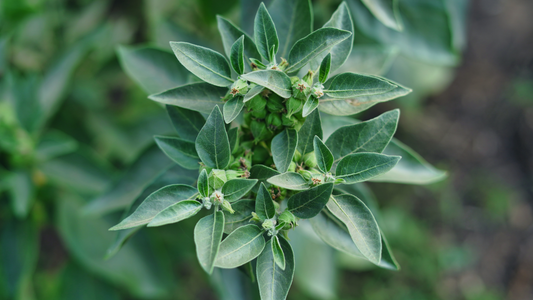- Blog
- Mumijo Shilajit Ingredients - Scientifically Analyzed

Mumijo Shilajit Ingredients - Scientifically Analyzed
Shilajit Ingredients: The natural active ingredient complex from the Himalayas
Shilajit is considered one of the most valuable substances in Ayurvedic medicine. This black-brown, resinous substance forms over centuries in the rock crevices of the Himalayas through the decomposition of various plant species. The special climatic conditions and microbial processes lead to the formation of a unique active ingredient complex. Traditional healers have used Shilajit for thousands of years as a tonic and to support various healing processes. Modern scientific studies of Shilajit ingredients increasingly confirm the diverse positive properties of this natural substance.
The main components of Shilajit at a glance
Humic substances as the main component
The Mumijo Shilajit ingredients demonstrate significant therapeutic effects due to their special composition of humic substances. These complex organic compounds are formed during the decades-long decomposition of plant material. In particular, the contained fulvic acids show pronounced biological activity. They enhance the absorption of other active ingredients and support important metabolic processes in the body. Humic acids have anti-inflammatory effects and strengthen the immune system. The special composition of humic substances in Shilajit differs significantly from other natural sources and contributes significantly to its therapeutic effect.
Non-humic substances
The Mumijo ingredients include, in addition to the dominant humic substances, other bioactive compounds. These non-humic substances consist of minerals, trace elements, amino acids, and secondary plant compounds. Particularly noteworthy is the high proportion of dibenzo-alpha-pyrones, which act as strong antioxidants. Also included are phenolic compounds, organic acids, and various vitamins. The non-humic substances synergistically complement the effects of the humic substances. Scientific analyses show that it is precisely this combination that is responsible for the diverse health-promoting properties.
The mineral composition of Shilajit
Macrominerals
The mineral composition of the Shilajit ingredients is characterized by an exceptionally high proportion of macrominerals. Calcium dominates the mineral content with up to 50%, followed by potassium with about 20-25%. Magnesium and sodium are also present in significant amounts. These macrominerals are available in a highly bioavailable form and can be optimally absorbed by the body. The high concentration of calcium not only supports bone health but also shows positive effects on metabolism. Current studies indicate a possible anti-adipose potential due to the specific mineral combination.
Trace elements
The Mumijo Shilajit ingredients include, in addition to macrominerals, a variety of essential trace elements. Iron, zinc, copper, manganese, and selenium are detectable in significant amounts. The concentration of these minerals varies depending on the region of origin. Afghan Shilajit, for example, has a particularly high iron content. The trace elements play an important role in enzymatic processes and support the antioxidant effect. Noteworthy is the natural balance of the various trace elements, which ensures optimal mutual supplementation.
Organic ingredients in Shilajit
Proteins and Amino Acids
The protein content of the ingredients Shilajit is between 13-17% of the total mass and contains a wide range of essential amino acids. These proteins mainly come from the original plant materials that were transformed during the formation process. Particularly noteworthy is the high proportion of branched-chain amino acids (BCAA), which are important for muscle building and recovery. The amino acid sequences show remarkable stability and remain intact even after processing. The protein quality is determined by the balanced amino acid profile.
Other organic compounds
The Mumijo ingredients include, in addition to proteins, other important organic compounds. The steroid content is between 3.3-6.5% and includes various bioactive substances. Carbohydrates account for about 1.5-2% and are mainly present in the form of polysaccharides. Noteworthy is the low but significant alkaloid content of 0.05-0.08%. These organic compounds contribute to the adaptogenic effect and support the body's adaptability to various stress factors. The lipid content is 4-4.5% and contains essential fatty acids.
Regional differences in ingredients
Afghan Shilajit
The Shilajit ingredients from Afghanistan are characterized by an exceptionally high calcium content of over 50% of the mineral components. The analyses also show increased concentrations of potassium and sulfur. This specific composition results from the unique geological conditions of the Afghan mountain regions. The proportion of fulvic acids is above the average of other origin regions. The antioxidant activity of Afghan Shilajit reaches values of over 96% in the DPPH test. These parameters make Afghan Shilajit particularly valuable for therapeutic applications.
Pakistani Shilajit
The Mumijo Shilajit ingredients from Pakistan show a more balanced distribution of minerals. Potassium dominates with about 24%, followed by calcium with 21% and chlorine with 19%. Notably, the higher silicon content of about 15% compared to other regions is remarkable. The antioxidant effect reaches similarly high values of 95% as Afghan Shilajit. Characteristic are also increased concentrations of aluminum and barium. This specific composition reflects the unique geological conditions of the Pakistani mountain regions.
Application possibilities based on the ingredients
The diverse Shilajit ingredients allow for a wide range of applications. The high mineral concentration supports bone health and energy metabolism. Antioxidative components strengthen cell protection functions. The adaptogenic properties help with stress management. Fulvic acids improve the absorption of other nutrients. The anti-inflammatory properties of humic substances support the immune system. The Mumijo ingredients also show great potential in current research for neurodegenerative diseases and metabolic disorders.
Conclusion: The importance of the ingredients for the effect
The complex composition of Shilajit ingredients explains its diverse positive properties. The synergistic interplay of humic substances, minerals, trace elements, and bioactive compounds makes Shilajit a unique natural substance. Particularly noteworthy are the high antioxidant activity and the good bioavailability of the Mumijo ingredients. Regional differences in composition lead to specific efficacy profiles. Scientific research on the ingredients increasingly confirms the traditional knowledge about the health-promoting properties of Shilajit.
Source
Al-Salman, F., Ali Redha, A., & Al-Zaimoor, Z. (2020). Inorganic Analysis and Antioxidant Activity of Shilajit. International Journal of Scientific Research in Chemical Sciences, 7(3), 05-10.


